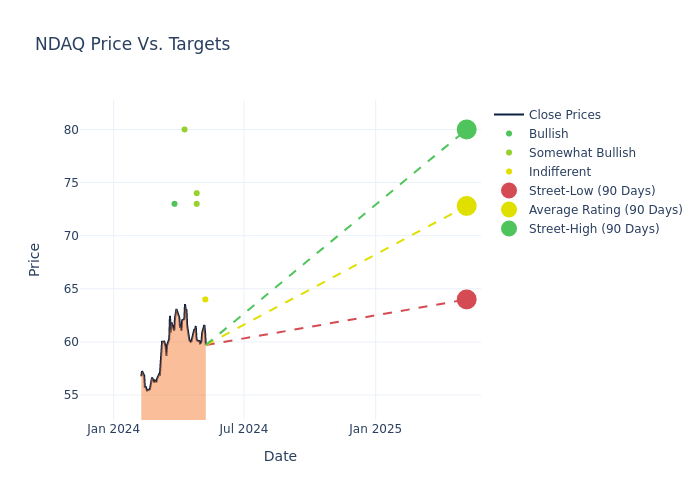Across the recent three months, 7 analysts have shared their insights on Nasdaq NDAQ, expressing a variety of opinions spanning from bullish to bearish.
In the table below, you'll find a summary of their recent ratings, revealing the shifting sentiments over the past 30 days and comparing them to the previous months.
| Bullish | Somewhat Bullish | Indifferent | Somewhat Bearish | Bearish | |
|---|---|---|---|---|---|
| Total Ratings | 2 | 4 | 1 | 0 | 0 |
| Last 30D | 0 | 0 | 1 | 0 | 0 |
| 1M Ago | 1 | 4 | 0 | 0 | 0 |
| 2M Ago | 1 | 0 | 0 | 0 | 0 |
| 3M Ago | 0 | 0 | 0 | 0 | 0 |
Analysts have recently evaluated Nasdaq and provided 12-month price targets. The average target is $73.71, accompanied by a high estimate of $80.00 and a low estimate of $64.00. Observing a 0.15% increase, the current average has risen from the previous average price target of $73.60.

Exploring Analyst Ratings: An In-Depth Overview
In examining recent analyst actions, we gain insights into how financial experts perceive Nasdaq. The following summary outlines key analysts, their recent evaluations, and adjustments to ratings and price targets.
| Analyst | Analyst Firm | Action Taken | Rating | Current Price Target | Prior Price Target |
|---|---|---|---|---|---|
| Andrew Bond | Rosenblatt | Lowers | Neutral | $64.00 | $76.00 |
| Benjamin Budish | Barclays | Lowers | Overweight | $73.00 | $76.00 |
| Kyle Voigt | Keefe, Bruyette & Woods | Lowers | Outperform | $74.00 | $75.00 |
| Andrew Bond | Rosenblatt | Lowers | Buy | $76.00 | $82.00 |
| Benjamin Budish | Barclays | Announces | Overweight | $76.00 | - |
| Michael Cyprys | Morgan Stanley | Raises | Overweight | $80.00 | $59.00 |
| Alexander Blostein | Goldman Sachs | Announces | Buy | $73.00 | - |
Key Insights:
- Action Taken: Analysts frequently update their recommendations based on evolving market conditions and company performance. Whether they 'Maintain', 'Raise' or 'Lower' their stance, it reflects their reaction to recent developments related to Nasdaq. This information provides a snapshot of how analysts perceive the current state of the company.
- Rating: Analysts unravel qualitative evaluations for stocks, ranging from 'Outperform' to 'Underperform'. These ratings offer insights into expectations for the relative performance of Nasdaq compared to the broader market.
- Price Targets: Understanding forecasts, analysts offer estimates for Nasdaq's future value. Examining the current and prior targets provides insight into analysts' changing expectations.
For valuable insights into Nasdaq's market performance, consider these analyst evaluations alongside crucial financial indicators. Stay well-informed and make prudent decisions using our Ratings Table.
Stay up to date on Nasdaq analyst ratings.
Delving into Nasdaq's Background
Founded in 1971, Nasdaq is primarily known for its equity exchange, but in addition to its market-services business (about 35% of sales), the company sells and distributes market data as well as offers Nasdaq-branded indexes to asset managers and investors through its information-services segment (30%). Nasdaq's corporate-services business (20%) offers listing services and related investor relations products to publicly traded companies and through the company's market technology group (15%), Nasdaq facilitates the exchange operations of other exchanges throughout the world and provides financial compliance services.
Nasdaq's Financial Performance
Market Capitalization: With restricted market capitalization, the company is positioned below industry averages. This reflects a smaller scale relative to peers.
Revenue Growth: Nasdaq's revenue growth over a period of 3 months has been noteworthy. As of 31 March, 2024, the company achieved a revenue growth rate of approximately 9.2%. This indicates a substantial increase in the company's top-line earnings. In comparison to its industry peers, the company trails behind with a growth rate lower than the average among peers in the Financials sector.
Net Margin: Nasdaq's net margin is below industry averages, indicating potential challenges in maintaining strong profitability. With a net margin of 13.98%, the company may face hurdles in effective cost management.
Return on Equity (ROE): Nasdaq's ROE falls below industry averages, indicating challenges in efficiently using equity capital. With an ROE of 2.16%, the company may face hurdles in generating optimal returns for shareholders.
Return on Assets (ROA): Nasdaq's ROA is below industry averages, indicating potential challenges in efficiently utilizing assets. With an ROA of 0.75%, the company may face hurdles in achieving optimal financial returns.
Debt Management: The company faces challenges in debt management with a debt-to-equity ratio higher than the industry average. With a ratio of 0.96, caution is advised due to increased financial risk.
The Basics of Analyst Ratings
Within the domain of banking and financial systems, analysts specialize in reporting for specific stocks or defined sectors. Their work involves attending company conference calls and meetings, researching company financial statements, and communicating with insiders to publish "analyst ratings" for stocks. Analysts typically assess and rate each stock once per quarter.
Some analysts publish their predictions for metrics such as growth estimates, earnings, and revenue to provide additional guidance with their ratings. When using analyst ratings, it is important to keep in mind that stock and sector analysts are also human and are only offering their opinions to investors.
If you want to keep track of which analysts are outperforming others, you can view updated analyst ratings along withanalyst success scores in Benzinga Pro.
This article was generated by Benzinga's automated content engine and reviewed by an editor.
© 2024 Benzinga.com. Benzinga does not provide investment advice. All rights reserved.
Comments
date | ticker | name | Price Target | Upside/Downside | Recommendation | Firm |
|---|
Trade confidently with insights and alerts from analyst ratings, free reports and breaking news that affects the stocks you care about.